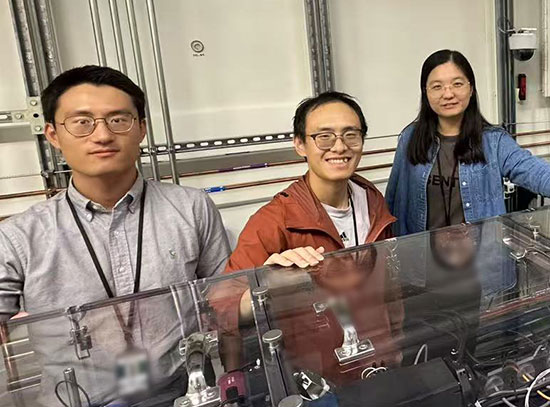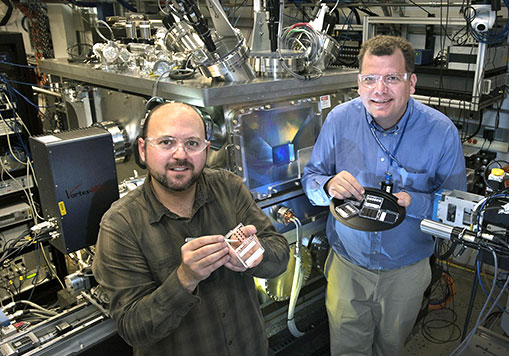
Imaging and Microscopy
Imaging and quantifying the morphology, structure, chemistry, elemental variations, and strain distribution of materials
The Imaging and Microscopy Program at Brookhaven Lab’s National Synchrotron Light Source II (NSLS-II) offers specialized tools for imaging and characterizing heterogeneous materials in both 2-D and 3-D. The program provides a suite of imaging techniques, which can be paired with spectroscopic analysis to study features ranging from the millimeter to nanometer regime. The program’s scientific focus is highly diverse, and includes studies on nanomaterials, energy conversion, biological structures, and climate science.
Program Beamlines
Hard X-ray Nanoprobe
The HXN beamline offers scientists a highly advanced suite of analytical tools for imaging and characterizing complex materials at the nanoscale. HXN provides world-leading spatial resolution, unique detection capabilities, and analytical tools that allow scientists to study the structural, elemental, chemical, and crystalline properties of their samples with an unprecedented level of detail.
Tender Energy X-ray Absorption Spectroscopy
The TES beamline provides advanced microscopy and microbeam spectroscopy tools for investigating the detailed structure of materials using tender (1-5 keV) x-rays. TES offers user-tunable spatial resolution as well as in situ electrochemistry, and primarily serves the energy, environmental, climate, and planetary sciences.
X-ray Fluorescence Microprobe
The XFM beamline offers scientists unique and versatile tools for characterizing elemental abundances and chemical speciation in heterogeneous materials. XFM spans a broad energy range and is designed for multimodal and mesoscale imaging, as well as spatially-resolved spectroscopy in diverse scientific fields, including catalysis and energy sciences as well as biology, environmental sciences and energy sciences.
Full Field X-ray Imaging
The FXI beamline offers advanced capabilities for studying the morphology and oxidation states of dynamic systems in 2-D and 3-D. FXI is specialized in in situ and operando studies of energy storage devices, as well as environmental, biological, and materials science samples.
Submicron Resolution X-ray Spectroscopy
The SRX beamline provides world-leading x-rays for studying complex, natural, and engineered systems using advanced imaging and spectroscopy techniques with sub-micron spatial resolution. The expertise of the SRX staff is aligned with the beamline’s diverse user community, which ranges from environmental and life sciences to materials science and energy conversion.
Bragg Coherent Diffraction Imaging
The extremely high spectral brightness of NSLS-II offers perfect conditions for novel imaging techniques such as coherent diffraction imaging. The Imaging and Microscopy Program is currently developing a beamline using this novel approach to reveal structures in 3-D at extremely high spatial resolution.
Imaging & Microscopy News

Patchy Nanoparticles by Atomic Stenciling

Destination: Mars. First Stop: Iceland?

Biologists Engineer Larger, Tougher Crops for Fuel, Bioproducts

Collaborative Team from Virginia Tech, George Mason University, and Brookhaven National Laboratory Wins Top Awarding in 4-VA

Ryugu Asteroid Research Reveals Mineral History Predating Any on Earth
Our Partners
Partnership for Earth, Environmental, and Planetary Science (PEEPS)
The partner user group consists of scientists, postdocs, and students from the University of Chicago’s Center for Advanced Radiation Sources, University of Kentucky’s Center for the Environmental Implications of Nanotechnology, and University of Delaware’s Delaware Environmental Institute. A fundamental goal is to develop and apply spatially-resolved X-ray analytical techniques for advancing the understanding of (1) geochemical and biochemical behavior of contaminants in the environment, (2) processes that control the fate, transformation and effects of engineered nanomaterials in the environment, and (3) the origin and evolution of the Solar System through analyses of extraterrestrial materials. PEEPS contributions to XFM include on-site staff, expertise in beamline development and operation, analytical techniques, and beamline equipment.
Tender Energy Microspectroscopy Consortium
This partner user group consists of 13 scientists from 9 institutions including Stony Brook University, Miami University, University of Delaware’s Delaware Environmental Institute, Lawrence Berkeley National Laboratory, North Carolina State University, State University of New York Plattsburgh, Skidaway Institute of Oceanography, Princeton University, and University of California Santa Cruz. Their common aim is the understanding of heterogeneous natural materials and systems at the microscale. This encompasses the areas of geochemistry, soil science, cosmochemistry, environmental science, climate and atmospheric sciences, and marine science, all of these with a primary focus on the distribution, speciation, bioavailability, and local- to global-scale cycling of nutrients and contaminants. The Consortium provided the majority of beamline optics and endstation instrumentation, design effort, and helped with the construction of the TES beamline.
Synchrotron Catalysis Consortium
This partner user group is led by principle investigators from Brookhaven National Laboratory, Columbia University and Stony Brook University. Their mission is to cultivate, support and educate the catalysis user community through partnerships with the TES and QAS beamlines. The SCC provides user support for catalysis users, and collaborates with NSLS-II to develop in situ capabilities for both beamlines.







